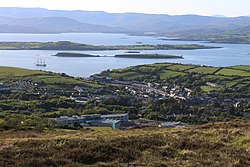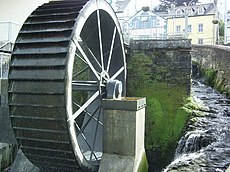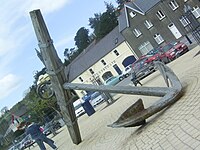Bantry
| Bantry Irish: Beanntraí | |
| County Cork | |
|---|---|
 Bantry from the southeast | |
| Location | |
| Grid reference: | V997488 |
| Location: | 51°40’47"N, 9°27’12"W |
| Data | |
| Population: | 2,722 (2016) |
| Postcode: | P75 |
| Dialling code: | 027 |
| Local Government | |
| Dáil constituency: |
Cork South-West |
| Website: | Bantry.ie |
Bantry is a town in the Barony of Bantry on the south-west coast of County Cork. It stands at the head of Bantry Bay, a deep-water gulf extending for eighteen miles to the west. The Beara Peninsula is to the northwest, with Sheep's Head peninsula to the southwest.
The name of the place is from the Irish Beanntraí, meaning '(place of) Beann's people'.
The focus of the town is a large square, formed partly by infilling of the shallow inner harbour. In former times, this accommodated regular cattle fairs; after modernising as an urban plaza, it now features a weekly market and occasional public functions. Two piers protect the harbour.
As of the early 21st century, Bantry has been a port of call for smaller cruise liners, which anchor between the town and Whiddy Island.[1][2]
History
As with other areas on Ireland's south-west coast, Bantry claims an ancient connection to the sixth-century saint Brendan the Navigator. In Irish lore, St Breandán was the first person to discover America. To the west of the town is the graveyard marking the site of a 15th-century Franciscan friary, of which nothing remains.[3]
In past centuries, Bantry was a base for major pilchard fisheries and was visited by fishing fleets from Spain, France and the Netherlands.[3] It was still a very small town in 1689 when it was described by the Jacobite army officer and future author John Stevens as "a miserable poor place, hardly worth the name of a town", consisting of "seven or eight small houses, and some mean little cottages".
Wolfe Tone Square in the town commemorates Theobald Wolfe Tone, a leader during the 1798 rebellion. In the lead up to the rebellion, Dublin-born Tone led the republican United Irishmen in what he had hoped would be a local re-run of the recent French Revolution; this was to be achieved with the help of French Republicans in overthrowing British rule. The ill-fated French invasion fleet, known as the French expedition to Ireland, arrived in the area in 1796, but its purpose was frustrated by unfavourable winds.[4] For his efforts in preparing the local defences against the French, Richard White, a local landowner, was created Baron Bantry in 1797.[5] A Viscountcy followed in 1800 and in 1816 he became the 1st Earl of Bantry. The mansion and gardens in the Bantry House demesne on the outskirts of the town testify to the family's status.[6]
During the Irish War of Independence, the 5th Cork Brigade of the Irish Republican Army was active in Bantry, and some members remained so during the Civil War that followed. Action by British forces included the punitive firebombing of several buildings in the town.
Sheltering the head of the bay is Whiddy Island, site of a large oil terminal, originally owned by Gulf Oil. On 8 January 1979 the oil tanker Betelgeuse exploded, killing all 42 crew members, as well as seven employees at the terminal. The jetty was seriously damaged, but the storage tanks were not affected. Nevertheless, 250 employees at the terminal, one of the largest employers in the region, lost their jobs. There was also significant environmental impact and the local fishing industry was affected. Local interests subsequently initiated mussel-farming in the sheltered waters between Whiddy and the town.
In 1986, Gulf Oil surrendered its lease on the site to the Irish government as a strategic oil reserve: it currently holds one-third of the national strategic petroleum reserve, though it has since been e-privatised.
About the town
- Bantry House, west of the town, home to the White family since 1739 – sometimes Earls of Bantry. It contains a number of historic artefacts and paintings and is surrounded by formal gardens.
- Bantry Market House
Churches:
- Church of Ireland: St Brendan The Navigator Church
- Roman Catholic: St Finbarr's
Events
Bantry hosts two cultural events each summer – the West Cork Chamber Music Festival and the West Cork Literary Festival. These feature musicians and writers of international stature, with performances at various venues in the town.[7]
Bantry held the Atlantic Challenge International Contest of Seamanship in July 2012, in which 15 nations competed.[8]
The inner harbour contains a marina comprising 40 berths and associated facilities, opened in 2017.[9]
Sport
- Football: Bantry Bay Rovers A.F.C.
- Gaelic Athletics: The Bantry Blues
- Golf: Bantry Bay Golf Club
- Rugby
- Rowing
- Sailing: Bantry Bay Sailing Club
Books
- Bantry Bay : Ireland in the days of Napoleon and Wolfe Tone. P. Brendan Bradley, 1931.
- Bantry in Olden Days: Richard S. Harrison (Published by Author)
- J. Kevin Hourihane, Town Growth in West Cork: Bantry 1600–1900 in JCHAS (1977), LXXXii, no 236, 83–97.
- Wild Gardens: The Lost Demesnes of Bantry Bay Nigel Everett, Hafod Press.
- An Irish Arcadia: The Historic Gardens of Bantry House Nigel Everett, Hafod Press 1999 ISBN 0-9535995-0-7
- Reminiscences and recipes of Bantry : A century in the life of a town, its people and their food Denis Cotter, (Editor), 1999.
- It might have been but yesterday : a Bantry anthology Denis Cotter (editor), 2000.
- What the doctor ordered, a third Bantry anthology, compiled by Denis Cotter, Pooky Paw Press Bantry, 2000.
- Speaking Volumes, Edith Newman Devlin, Blackstaff Press 2000 ISBN 0-85640-672-4, Bantry in early 1920s.
- The Memoirs of John M. Regan, a Catholic Officer in the RIC and RUC, 1909–48, Joost Augusteijn, editor, District Inspector, Bantry, 1919, ISBN 978-1-84682-069-4.
- Picturesque Bantry : a century in photographs, Denis Cotter. 2005.
Outside links
| ("Wikimedia Commons" has material about Bantry) |
References
- ↑ "Cruise Liner Schedule". Bantry Bay Port Company DAC. https://www.bantrybayport.com/cruise_liner_schedule.
- ↑ "Cruise Ships". Bantry Development and Tourism Association. https://www.visitbantry.ie/discover-bantry/cruise-ships.html.
- ↑ 3.0 3.1 W. O'Halloran (1916). Early Irish History and Antiquities and the History of West Cork. Sealy, Bryers and Walker. https://www.libraryireland.com/WestCorkHistory/Bantry.php.
- ↑ Samuel Lewis (1837). Topographical Dictionary of Ireland. Lewis. https://www.libraryireland.com/topog/B/Bantry-Bantry-Cork.php.
- ↑ "The Story of Bantry House By Geoffrey Shelswell-White". Irish Tatler and Sketch. May 1951. https://www.bantryhouse.com/images/The-Story-of-Bantry-House-by-GSW.pdf.
- ↑ "Bantry House – A Snapshot of History". http://www.bantryhouse.com/the-house.html.
- ↑ "2018/19 Concert Series Announced". West Cork Music. 17 September 2018. https://www.westcorkmusic.ie/2018-19-concert-series-announced-2/.
- ↑ "Atlantic Challenge International – Past Events". http://atlanticchallenge.org/events/past.
- ↑ "Bantry Harbour Marina Officially Opened, 40 Boats Visit New Irish Coastal Facility". Afloat Magazine. 12 August 2017. https://afloat.ie/port-news/irish-marinas/item/36837-bantry-harbour-marina-officially-opened-40-boats-visit-new-irish-coastal-facility.

